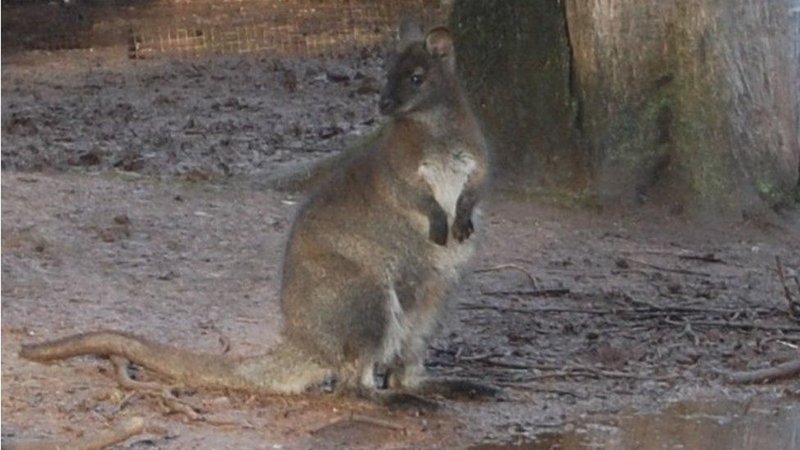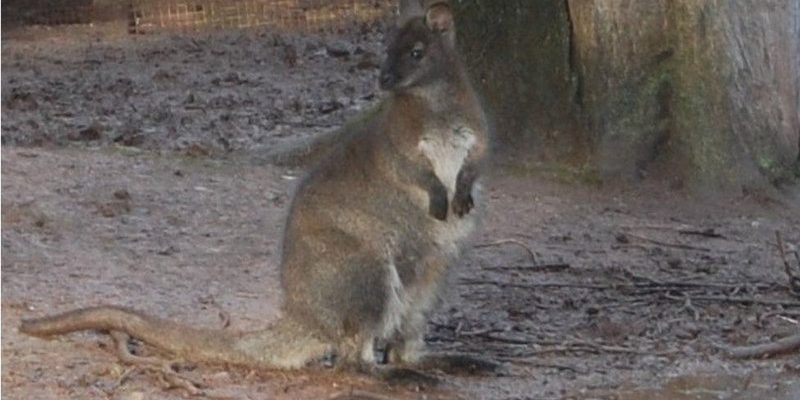
Imagine a smaller, cuter version of a kangaroo, hopping around the Australian outback. That’s a wallaby! These adorable marsupials belong to the Macropod family, which means “big foot.” Wallabies are quite diverse, with many species exhibiting unique traits. They usually have a compact body, powerful hind legs, and a long tail, all adaptations that make them excellent jumpers. If you’ve ever seen one in action, you’ll know just how graceful these little creatures can be.
Wallabies are primarily native to Australia and New Guinea, although some species can be found on nearby islands. They thrive in various habitats, from forests and grasslands to rocky outcrops. Their friendly demeanor and curious nature make them a favorite among wildlife enthusiasts and tourists alike. Plus, they have a knack for blending into their surroundings, which adds to their charm!
Physical Characteristics
Wallabies share some common traits that make them easily identifiable. They have short front limbs and long, strong hind legs, allowing them to hop quickly and efficiently. Depending on the species, wallabies can range in size from a mere 12 inches to over three feet tall. Their fur varies in color—from the rich browns of the Red-Necked Wallaby to the striking grey of the Agile Wallaby. It’s not hard to see why they’re so beloved in Australian culture.
One of their most fascinating features is their tails. Wallabies have long, muscular tails that help them balance while hopping and standing upright. Think of their tail as a counterweight, providing stability as they navigate through their environment. This balance is crucial, especially when they’re bounding away from potential threats such as predators.
| Characteristic | Details |
|---|---|
| Size: | 12 inches to 3 feet tall |
| Weight: | 4 to 50 pounds, depending on the species |
| Habitat: | Forests, grasslands, rocky areas |
| Diet: | Grasses, leaves, fruits |
| Lifespan: | Up to 15 years in the wild |
| Behavior: | Social; typically found in small groups |
Diet and Eating Habits
Wallabies are herbivores, which means they primarily eat plant material. They have a special digestive system that allows them to break down tough grasses and leaves efficiently. Their diet includes a variety of vegetation, which can vary depending on their habitat. Some wallabies prefer the sweet taste of grass, while others enjoy munching on leaves and shrubs.
Interestingly, wallabies have a unique way of feeding. They tend to graze during the cooler hours of the day, usually at dawn and dusk. This helps them avoid the heat of the day and the attention of predators. You might catch them nibbling away in a more relaxed manner, maybe even sitting on their haunches while enjoying a meal. They’re quite the sight!
To keep their energy levels up, wallabies have to consume a substantial amount of food. They can spend several hours a day foraging and munching on their favorite snacks. Plus, their teeth are specially adapted to help them grind down tough fibrous plants, so they always make the most out of their meals.
Social Structure and Behavior
You might picture wallabies as solitary creatures, but many species are quite social. They often form small groups called mobs, typically consisting of a few females and their young. Male wallabies are generally more solitary, especially outside mating seasons. This social structure helps them protect one another from predators. When danger approaches, you can see them hopping in unison, showcasing their agility and teamwork!
Wallabies communicate with each other through a range of vocalizations, body language, and even scent marking. You might hear them grunt, grunt-whistle, or even make a clicking sound when they’re excited or alarmed. It’s adorable when you think about it; they have their own little language!
In the wild, wallabies are usually most active in the early morning or late afternoon, avoiding the midday heat. They spend a lot of time grooming themselves and each other, which is a crucial part of their social interactions. This bonding time strengthens relationships within the group and helps maintain their social structure.
Habitat and Distribution
Wallabies are primarily found across Australia and New Guinea, but their range can be quite broad. They’re highly adaptable animals that thrive in various environments, from rainforests and wet sclerophyll forests to dry scrublands and grasslands. Some species, like the Black-Flanked Rock Wallaby, even enjoy rocky terrains!
Many wallabies prefer to live in dense vegetation where they can easily hide from predators and find food. This camouflage is essential for their survival, as they’re often hunted by foxes, eagles, and even domestic dogs. They have an innate ability to blend into their surroundings, making them elusive and fascinating to watch in their natural habitat.
As human activity expands into their territories, wallabies face growing challenges. Habitat loss due to agriculture and urban development is a significant concern. Conservation efforts are ongoing to help protect their natural homes and ensure these charming creatures can continue to thrive.
Reproduction and Lifespan
Wallaby mating behavior can be quite interesting. When a female is in estrus, males will compete for her attention, using displays of strength and agility. After mating, the female will give birth to a tiny, underdeveloped joey, which then crawls into her pouch for continued development. It’s like a little miracle happening right there!
Once in the pouch, the joey will latch on to a teat and stay there for several months. As it grows, the joey will begin to peek out of the pouch, getting curious about the world outside. Eventually, it will start to venture out for short periods while still returning to the safety of mom’s pouch.
In the wild, wallabies can live up to 15 years, although factors like predation and environmental conditions can impact their lifespan significantly. In captivity, with proper care, they can live even longer, allowing enthusiasts to enjoy their charming personalities for many more years.
Conservation Status
While many wallaby species are relatively common, some face significant threats due to habitat loss and hunting. The Eastern Grey Wallaby, for instance, is not considered endangered, but others, like the Yellow-Footed Rock Wallaby, have seen their populations decline drastically. Conservation programs are crucial in protecting these vulnerable species and preserving their habitats.
Efforts to conserve wallabies often involve habitat restoration, which can include creating wildlife corridors to connect fragmented areas. Education plays a key role in fostering a love for these marsupials among local communities, which can help ensure their future.
Community involvement and awareness can make a remarkable difference. Supporting wildlife sanctuaries and participating in local conservation initiatives can help protect these incredible creatures. After all, they’re part of a broader ecosystem that deserves our care and respect!
FAQ
Can wallabies be kept as pets?
Keeping wallabies as pets is a bit tricky. They require specific conditions and care that can be hard to replicate in a typical household. Wallabies are social animals that thrive in their natural environments, so they might not be the best fit for everyone. Additionally, laws regarding wallaby ownership vary by location, so always check local regulations before considering one as a pet.
How do wallabies protect themselves from predators?
Wallabies have several strategies to evade predators. Their keen eyesight allows them to detect threats from a distance. They also blend into their surroundings exceptionally well, making it challenging for predators to spot them. If a wallaby feels threatened, it can quickly hop away—sometimes reaching speeds of up to 30 miles per hour!
Are there different species of wallabies?
Yes, there are over 30 species of wallabies! Some of the most well-known include the Agile Wallaby, the Black-Flanked Rock Wallaby, and the Red-Necked Wallaby. Each species has its own unique characteristics, habitats, and behaviors, making them fascinating to study and observe.
What do wallabies eat in the wild?
In the wild, wallabies primarily eat grasses, leaves, and fruits. Their diet can vary greatly depending on their specific habitat and the availability of different plant types. They are excellent foragers and spend a good part of their day searching for tasty vegetation to munch on.
How can I help wallabies and their habitats?
You can help wallabies by supporting conservation efforts in your area. This might include volunteering with local wildlife organizations, participating in habitat restoration projects, or making donations to groups focused on wildlife protection. Educating others about the importance of conserving these beautiful creatures is also crucial!
What is the difference between a wallaby and a kangaroo?
The main differences lie in their size and habitat. Wallabies are generally smaller and tend to prefer different environments than kangaroos. While kangaroos are more common in open grasslands, wallabies often inhabit forests or bushy areas. Both belong to the same family but display distinct characteristics based on their adaptations.
Are wallabies social animals?
Yes, many wallabies are quite social! They often gather in small groups called mobs. Social interactions between wallabies include grooming, vocalizations, and playful behavior. This social structure is essential for their survival, providing both companionship and safety in numbers.
Do wallabies have any natural predators?
In the wild, wallabies face threats from various predators, including foxes, hawks, and dingoes. These natural predators rely on their hunting skills to capture wallabies. That’s why wallabies have evolved so many adaptations, like their keen senses and agility, to evade these dangers.
How do wallabies reproduce?
Wallabies reproduce similarly to kangaroos. After mating, the female gives birth to a tiny, underdeveloped joey, which moves into her pouch to continue developing. The joey stays in the pouch for several months before gradually becoming more independent as it grows. This reproductive strategy is a defining feature of all marsupials.
What role do wallabies play in their ecosystem?
Wallabies play a vital role in their ecosystems. As herbivores, they help control plant growth and contribute to seed dispersal, promoting healthy vegetation. By grazing on various plants, they shape the habitat, supporting a diverse range of species, which in turn sustains the food web. Their presence is essential for maintaining ecological balance.
Are wallabies in danger of extinction?
While some wallaby species are thriving, others are at risk of becoming endangered due to habitat destruction and hunting. Conservation efforts are essential to protect vulnerable species and their natural habitats. Awareness and support from the public can greatly impact their survival.

